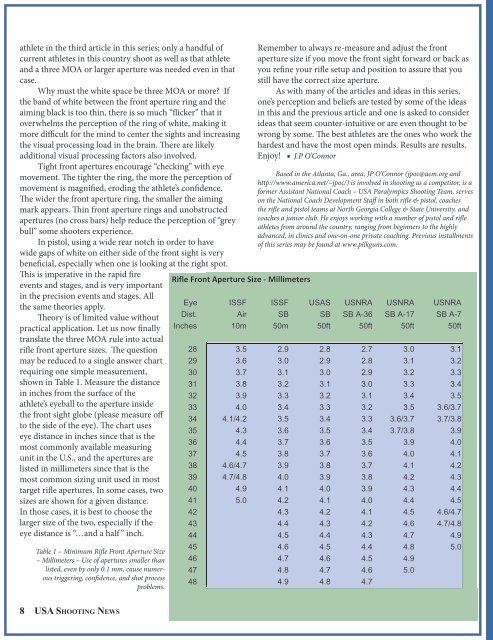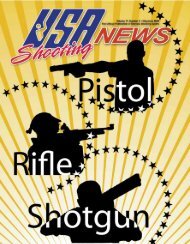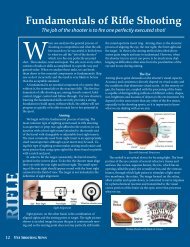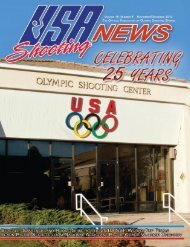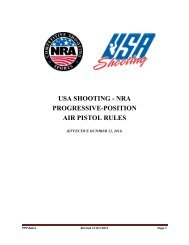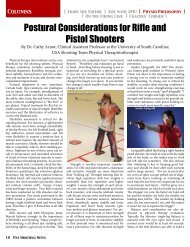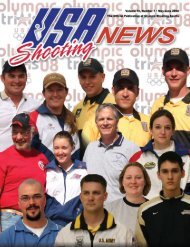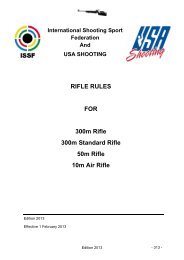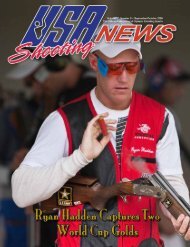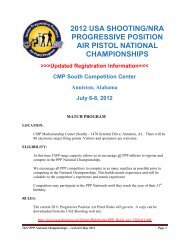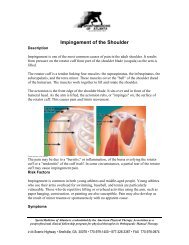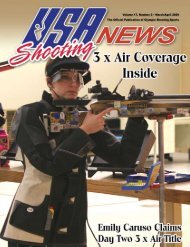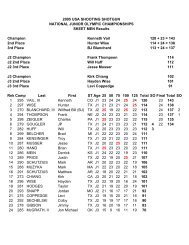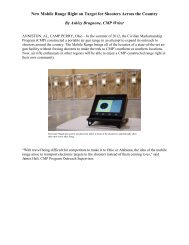January/February 2011: Volume 19, Number 1 - USA Shooting
January/February 2011: Volume 19, Number 1 - USA Shooting
January/February 2011: Volume 19, Number 1 - USA Shooting
You also want an ePaper? Increase the reach of your titles
YUMPU automatically turns print PDFs into web optimized ePapers that Google loves.
athlete in the third article in this series; only a handful of<br />
current athletes in this country shoot as well as that athlete<br />
and a three MOA or larger aperture was needed even in that<br />
case.<br />
Why must the white space be three MOA or more? If<br />
the band of white between the front aperture ring and the<br />
aiming black is too thin, there is so much “flicker” that it<br />
overwhelms the perception of the ring of white, making it<br />
more difficult for the mind to center the sights and increasing<br />
the visual processing load in the brain. There are likely<br />
additional visual processing factors also involved.<br />
Tight front apertures encourage “checking” with eye<br />
movement. The tighter the ring, the more the perception of<br />
movement is magnified, eroding the athlete’s confidence.<br />
The wider the front aperture ring, the smaller the aiming<br />
mark appears. Thin front aperture rings and unobstructed<br />
apertures (no cross bars) help reduce the perception of “grey<br />
bull” some shooters experience.<br />
In pistol, using a wide rear notch in order to have<br />
wide gaps of white on either side of the front sight is very<br />
beneficial, especially when one is looking at the right spot.<br />
This is imperative in the rapid fire<br />
events and stages, and is very important<br />
in the precision events and stages. All<br />
the same theories apply.<br />
Theory is of limited value without<br />
practical application. Let us now finally<br />
translate the three MOA rule into actual<br />
rifle front aperture sizes. The question<br />
may be reduced to a single answer chart<br />
requiring one simple measurement,<br />
shown in Table 1. Measure the distance<br />
in inches from the surface of the<br />
athlete’s eyeball to the aperture inside<br />
the front sight globe (please measure off<br />
to the side of the eye). The chart uses<br />
eye distance in inches since that is the<br />
most commonly available measuring<br />
unit in the U.S., and the apertures are<br />
listed in millimeters since that is the<br />
most common sizing unit used in most<br />
target rifle apertures. In some cases, two<br />
sizes are shown for a given distance.<br />
In those cases, it is best to choose the<br />
larger size of the two, especially if the<br />
eye distance is “…and a half ” inch.<br />
Table 1 – Minimum Rifle Front Aperture Size<br />
– Millimeters – Use of apertures smaller than<br />
listed, even by only 0.1 mm, cause numerous<br />
triggering, confidence, and shot process<br />
problems.<br />
Rifle Front Aperture Size ‐ Millimeters<br />
Remember to always re-measure and adjust the front<br />
aperture size if you move the front sight forward or back as<br />
you refine your rifle setup and position to assure that you<br />
still have the correct size aperture.<br />
As with many of the articles and ideas in this series,<br />
one’s perception and beliefs are tested by some of the ideas<br />
in this and the previous article and one is asked to consider<br />
ideas that seem counter-intuitive or are even thought to be<br />
wrong by some. The best athletes are the ones who work the<br />
hardest and have the most open minds. Results are results.<br />
Enjoy! ■ J.P O’Connor<br />
Based in the Atlanta, Ga., area, JP O’Connor (jpoc@acm.org and<br />
http://www.america.net/~jpoc/) is involved in shooting as a competitor, is a<br />
former Assistant National Coach – <strong>USA</strong> Paralympics <strong>Shooting</strong> Team, serves<br />
on the National Coach Development Staff in both rifle & pistol, coaches<br />
the rifle and pistol teams at North Georgia College & State University, and<br />
coaches a junior club. He enjoys working with a number of pistol and rifle<br />
athletes from around the country, ranging from beginners to the highly<br />
advanced, in clinics and one-on-one private coaching. Previous installments<br />
of this series may be found at www.pilkguns.com.<br />
Eye ISSF ISSF <strong>USA</strong>S USNRA USNRA USNRA<br />
Dist. Air SB SB SB A-36 SB A-17 SB A-7<br />
Inches 10m 50m 50ft 50ft 50ft 50ft<br />
28 3.5 2.9 2.8 2.7 3.0 3.1<br />
29 3.6 3.0 2.9 2.8 3.1 3.2<br />
30 3.7 3.1 3.0 2.9 3.2 3.3<br />
31 3.8 3.2 3.1 3.0 3.3 3.4<br />
32 3.9 3.3 3.2 3.1 3.4 3.5<br />
33 4.0 3.4 3.3 3.2 3.5 3.6/3.7<br />
34 4.1/4.2 3.5 3.4 3.3 3.6/3.7 3.7/3.8<br />
35 4.3 3.6 3.5 3.4 3.7/3.8 3.9<br />
36 4.4 3.7 3.6 3.5 3.9 4.0<br />
37 4.5 3.8 3.7 3.6 4.0 4.1<br />
38 4.6/4.7 3.9 3.8 3.7 4.1 4.2<br />
39 4.7/4.8 4.0 3.9 3.8 4.2 4.3<br />
40 4.9 4.1 4.0 3.9 4.3 4.4<br />
41 5.0 4.2 4.1 4.0 4.4 4.5<br />
42 4.3 4.2 4.1 4.5 4.6/4.7<br />
43 4.4 4.3 4.2 4.6 4.7/4.8<br />
44 4.5 4.4 4.3 4.7 4.9<br />
45 4.6 4.5 4.4 4.8 5.0<br />
46 4.7 4.6 4.5 4.9<br />
47 4.8 4.7 4.6 5.0<br />
48 4.9 4.8 4.7<br />
8 <strong>USA</strong> <strong>Shooting</strong> News<br />
jan feb <strong>2011</strong>.indd 8<br />
1/3/<strong>2011</strong> 10:45:56 AM


